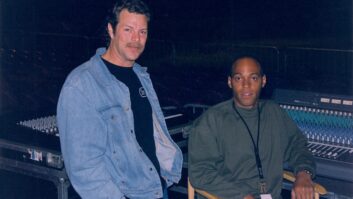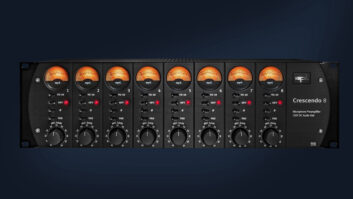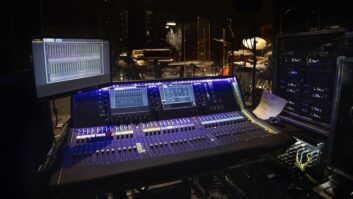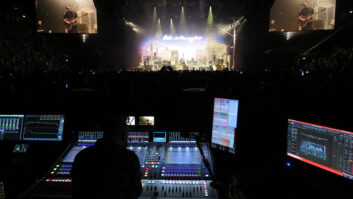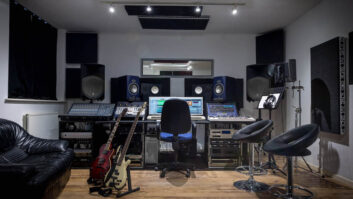I often find the pro audio products made by small companies to be
more compelling than those mass-produced by larger corporations. The
niche designer (frequently also the president of the company) usually
has an idealism and obsession with audio that I relate to.
Unfortunately, the result is often a stringently engineered,
rapturously musical product that costs too darn much for my pocketbook.
Not so with the Lawson L47MP, a supremely crafted, stunningly musical
microphone that, at $1,995, most professional studio owners can readily
afford.
STRIKING APPEARANCE
The L47MP is a multipattern, large-diaphragm tube condenser. Straight out of its bombproof (airtight
and watertight) Pelican storage case, the L47MP makes a bold statement.
Shaped much like an U47 and measuring an impressive 9¾ inches long
and 23/8 inches in diameter, virtually its entire body—including
cable connector and double-mesh head grille—is plated in 24-karat
gold. It’s a look you’ll either love or hate. Virtually all
of my clients think it looks gorgeous, and I agree.
Underneath the gold veneer, the mic’s body is machined from
solid brass, bead blasted and plated with nickel. Its substantial
weight (two pounds) and solid construction inspire confidence.
The Pelican case ships with the mic. Also included is a sturdy,
proprietary power supply and companion 6-foot, three-prong, detachable
IEC power cord. A knob on the power supply allows you to make
continuously variable adjustments to the mic’s polar pattern, from omni to cardioid to bi-directional (and all patterns in
between). A 30-foot, shielded Mogami cable (fitted with gold-plated
Neutrik connectors) is provided for hooking up the L47MP to a locking
6-pin XLR connector on the power supply; this delivers
power to and audio from the mic. Other features of the power supply
include a switch for padding the mic 12 dB, a power switch with inset red LED and a 3-pin
male XLR for audio output to your mixer/mic pre.
The 12dB pad comes after, not before, the output stage. From a
user’s perspective, I think most tube mics are better off padded
than pre-attenuated. The latter scheme often degrades the already
critical signal-to-noise in tube designs past the point of usefulness.
Lawson’s design makes sense.
A swiveling mic adapter, made of high-impact plastic, is also
supplied with the L47MP. As the capsule element is internally shock-
mounted, an external suspension mount is not needed. The mic is secured
by sliding its wide-diameter connector base into the adapter’s
split O-ring clamp, which is opened and closed by tightening a knurled
knob. This arrangement is the most hassle-free and foolproof scheme for
hanging a mic (upside down or right side up) I’ve seen. In fact,
the complete microphone system—right down to the rubber feet on
the power supply—demonstrates extensive forethought and
impeccable construction quality. This product is a joy to use.
INSIDE DETAIL
The L47MP’s capsule features dual 1-inch-diameter, gold-sputtered
membranes. Gene Lawson (president of Lawson Inc.) modeled the
capsule’s design after the M7 capsule used in the Neumann U47 and
M49 microphones, with modifications. For example, the diaphragms are
only 3 microns thick (the original M7’s were 7 microns) to
optimize transient and high-frequency response. Each capsule is
precision-machined from solid brass and then hand-lapped in the Lawson
lab.
At the heart of the L47MP is the venerable 6072 vacuum tube, coupled
through a Jensen transformer. Lawson stringently tests and selects the
tubes for all its mics to meet low-noise guidelines. Additionally, a
low-loss tube socket is employed, which uses military grade, heavily
gold-plated beryllium copper contacts for better grip, low contact
resistance and extended life.
The L47MP’s sensitivity at 1 kHz is rated a modest 11.4 mV/Pa,
and the A-weighted equivalent noise level is 22 dB SPL—typical
specs for a tube mic. The maximum SPL for 1% THD at 1 kHz is a very
modest 117 dB, suggesting careful placement on loud signal sources.
A cardioid-only version of the L47MP, the L47C, is available for
$1,695. Both mics are only sold factory-direct, which partially
explains how the prices can be kept so low.
THE SOUND
As with all multiple-pattern condensers, changing the L47MP’s
polar pattern results in a change of timbre, making for a very
versatile mic. The omni pattern exhibits a dip in the 3 to 5kHz range,
and a broad peak centered roughly at 10 kHz. As you increase the
L47MP’s directionality, the timbre becomes more and more present
as midrange response is boosted and very high frequency response is
diminished. The mic sounds quite bright in bidirectional mode.
My first critical listening test was an A/B/C comparison of the
Lawson L47MP, RØDE Classic and AKG C-12VR microphones, all set to
cardioid and recorded to separate ADAT tracks via a Millennia Media
HV-3 preamp and the Yamaha 02R’s 20-bit converters. The sound
source was female spoken word. The L47MP has a deeper bottom than the
Classic; I liken it to an AKG TLII on steroids in this regard. But the
L47’s bottom is not accentuated in the upper bass as with the
C-12VR, which has by far the overall biggest bottom of the three mics
(not necessarily always a good thing). The L47MP is more present in the
midrange frequencies than both the Classic and the C-12VR, which have a
darker sound even though they both offer more high-end sizzle and
better transient detail. All three mics have an uncanny ability to make
a sound source fatten or grow in perceived size, a cherished
characteristic of the best tube mics. In this regard, the L47MP sounds
fatter than the Classic, but the C-12VR takes the grand prize. The
C-12VR is also the smoothest-sounding of the three mics.
IN SESSION
When you tuck vocals recorded with an L47MP into a mix, something
magical happens. The track somehow manages to sound incredibly fat, yet
retains its presence. All the warm, lush texture you would want from a
tube mic is there.
Male rock and jazz vocals both had a tight, full bottom and a
velvety fat yet clear sound. Although these tracks were not
extraordinarily detailed up top, they nevertheless sounded more than
adequately articulate. This quality makes the L47MP a good choice for
recording sibilant singers.
Next up were some female vocals, recorded via the HV-3 to 24-bit
digital (the 02R’s V2 software allows you to record 24-bit audio
onto two ADAT tracks; you gotta hear this!). Six inches from the mic in
cardioid mode, the singer sounded warm yet clear, with a beautifully
soft and shimmering high end.
The L47MP has a very flattering proximity effect, but tends to overload when
you’re screaming right on top of it. The “wide
cardioid” position usually yielded the best results for recording
lead vocals; the figure-8 pattern often sounded too bright for this
application. The hypercardioid mode’s moderately boosted
presence was just the ticket for recording male rock backing vocals. A
testament to this mic is that I rarely had to employ any EQ to vocal
tracks at mixdown (the one exception being some low shelving EQ for a
vocalist who almost ate the mic).
The next task was recording a variety of Native American wood flutes
with timbres ranging from dark and soothing to bright and almost
shrill. The deeper and darker the inherent tone of the instrument, the
more directional pattern was called for. On mid-sized flutes, the
L47MP’s cardioid pattern was chosen for its softer, darker
midrange and breathy highs. The mic’s figure-8 pattern sounds
more present yet less detailed; this was a more complementary timbre
for some bassier flutes that had a raspy or beady high end.
Overall, the L47MP lent a rich, fat, warm, golden tone to the bigger
flutes. But on the smaller, soprano range flutes, the L47MP was a tad
too bright. The C-12VR produced a more flattering, softer, darker
timbre on those instruments.
The L47MP’s combination of warmth and presence make it a
natural for recording electric jazz guitar. The mic never sounded harsh
or glassy; instead, the sound was soft and round. Perfect! Similarly, I
got excellent results miking up the Leslie cabinet on an XB-2 Hammond
organ with the L47MP’s mode set approximately to supercardioid (only the omni, cardioid and
bi-directional modes are marked on the power supply).
Finally, I miked the cabinet of an electric bass guitar in figure-8
mode. This pattern’s hyped midrange and understated highs gave me
the hard-driving tone I was looking for on this rock ’n’
roll session. The timbre was perfect for rock bass: present, huge and
with a big, tight bottom.
CONCLUSIONS
If you’re in the market for a world-class tube condenser, you
cannot go wrong with the L47MP. It has the uncanny ability to sound
great on almost any vocalist, as well as on a wide variety of
instruments. The L47MP’s construction is impeccable, it looks
great, and it’s quite affordable. What more could you ask for? I
cannot praise this microphone enough. Don’t wait—buy
it.
Lawson, www.lawsonmicrophones.com
